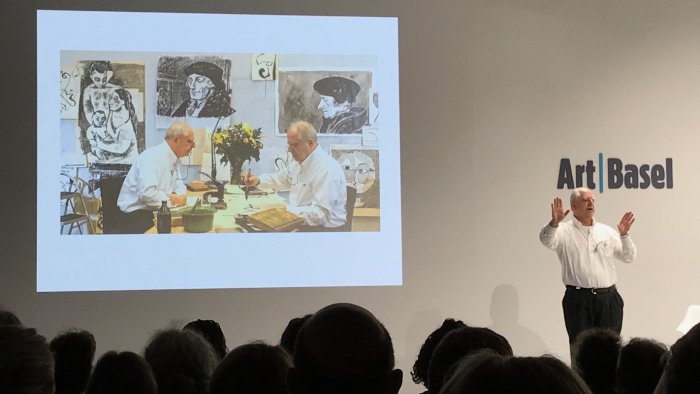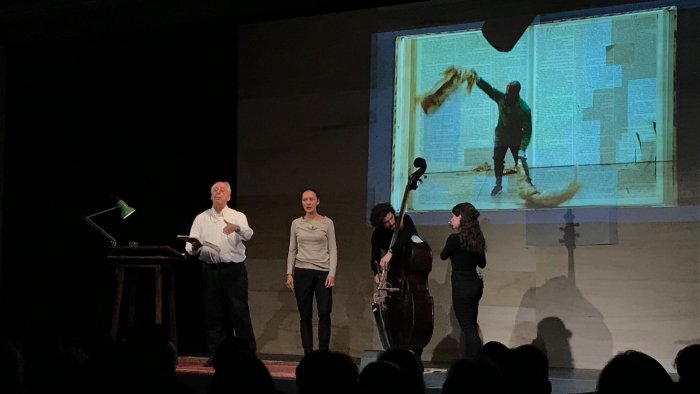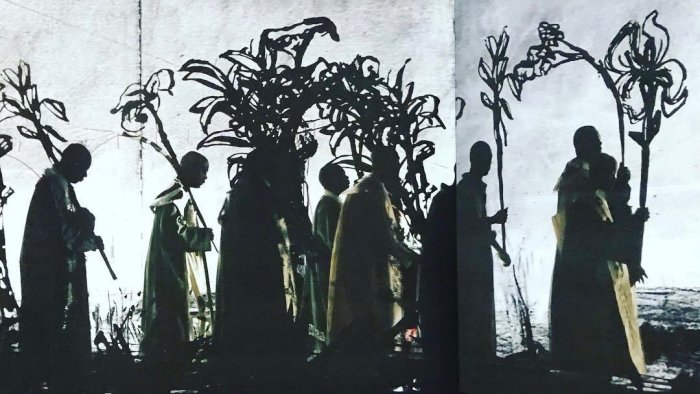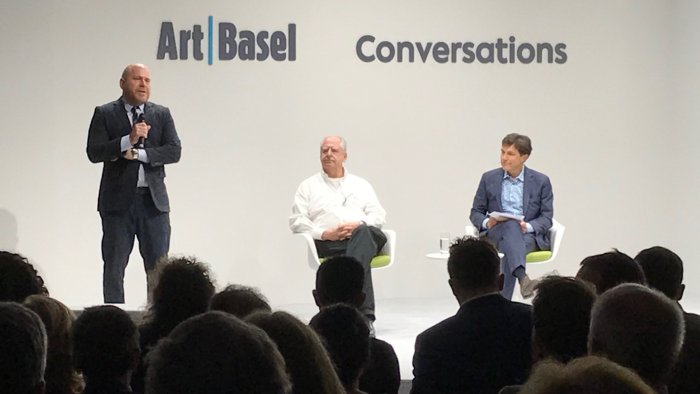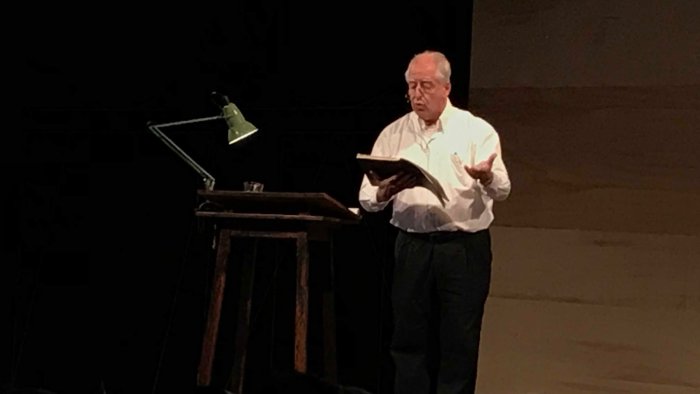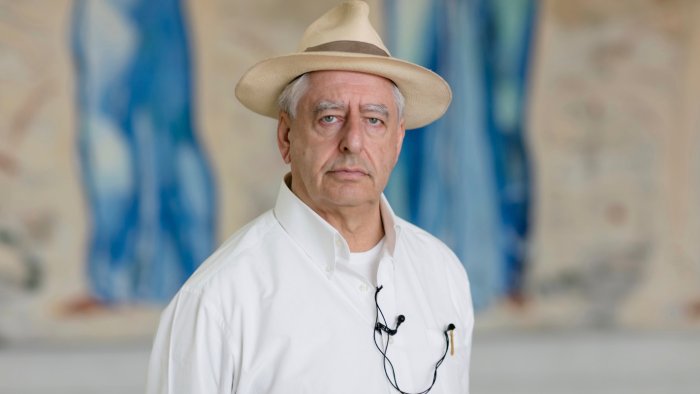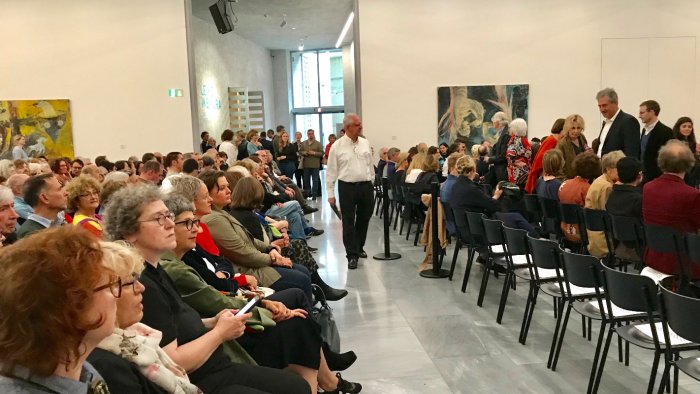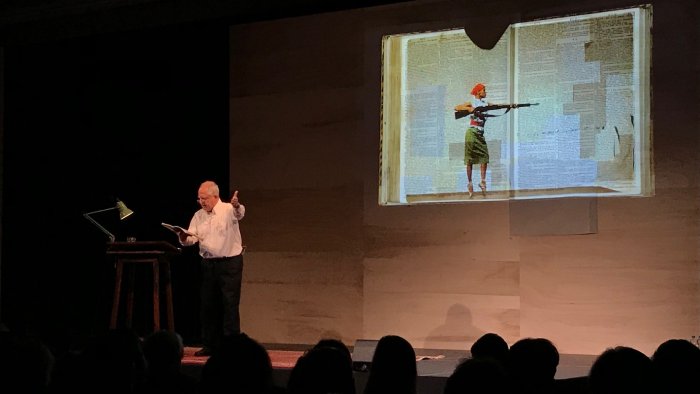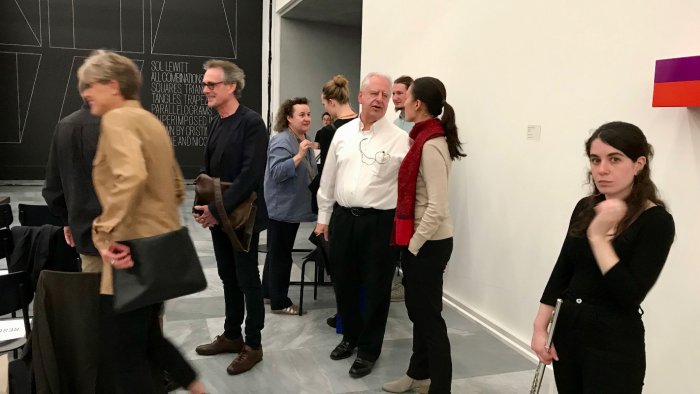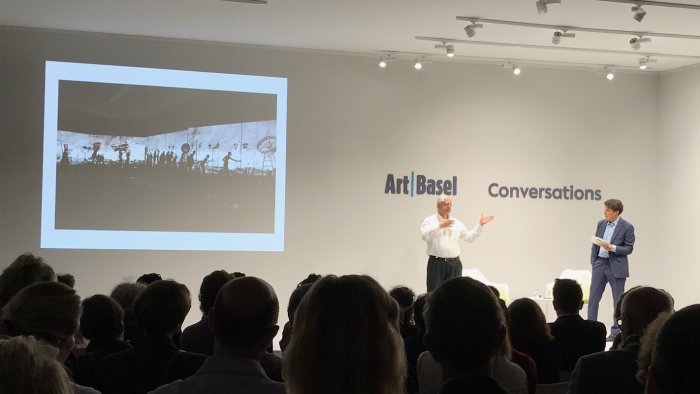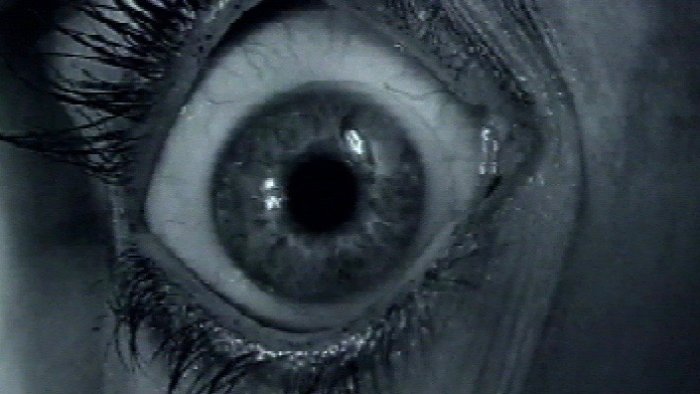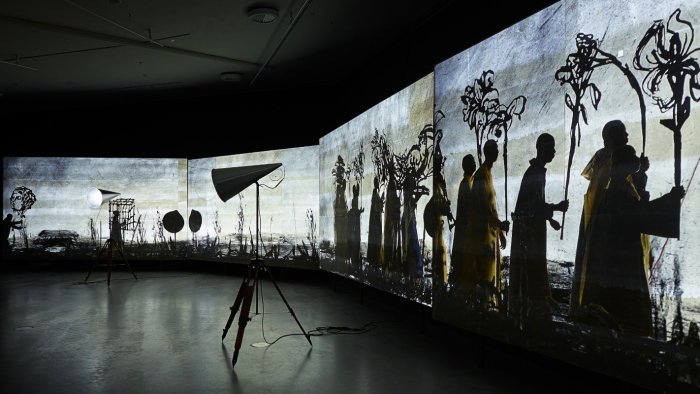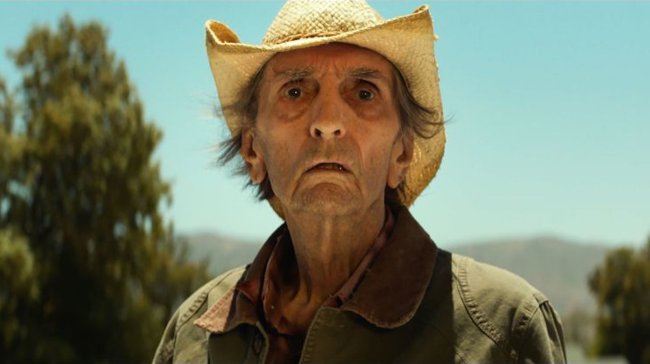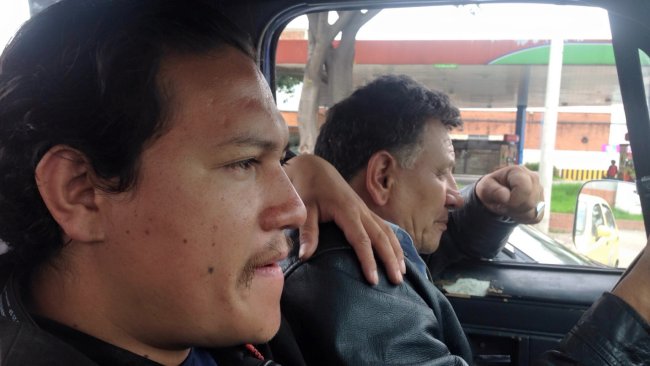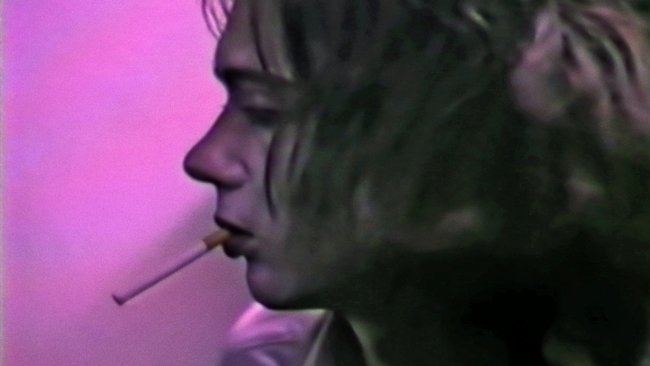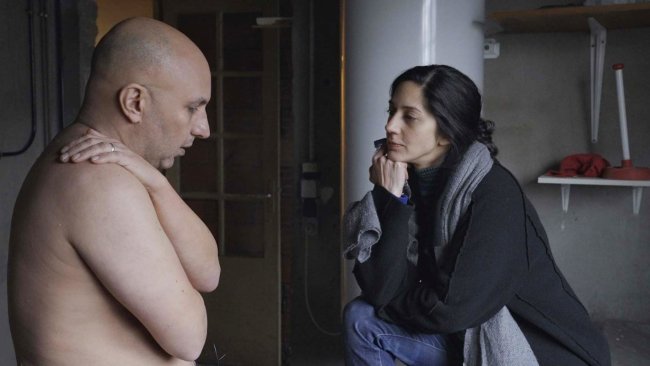William Kentridge in Basel
We have sent William Kentridge a pack of written questions, to which he gently answered with an audio message. Together with the questions, we report some statements of his – here below. Take the time for this exceptional podcast in collaboration with the artist!
The interview is followed by a text on William Kentridge’s presence in Basel.
[…] The movement at the centre of his moving images displays walking as a ritual of presentation and representation, lamentation and jubilation, celebration and claim. Drawing and video become the expressive branches of theatre.
Text: Giuseppe Di Salvatore | Audio/Video: Ruth Baettig
Podcast
Interview with William Kentridge about his work
Cencept & Editing: Ruth Baettig
Music excerpts: © William Kentridge
Find a list of all our Podcasts here.
All the questions - and some excerpts of the answers
-1- According to André Breton, Alfred Jarry’s favourite tools were the bicycle, the absinthe, and the revolver. Which one would you keep for yourself, or are your three favourite tools?
[…] Let’s say, the broken bicycle, the voice of a singer, and burned wood would be my favourite tools.
-2- Your artistic references lean mainly towards ancient and modern art. What in contemporary art does (not) inspire you?
[…] But the reference to other art generally has to go back rather than sideways. Otherwise, it becomes too much of an incestuous conversation between peers.
-3- Colonialism, and its aftermath, is the (probably only) global narrative of our times – actually, of our last couple of millennia… Now, any discourse on colonialism risks sharing the same delirious “globalitis” of this narrative (globalitis: the disease of being fascinated by global discourses). At the end of your Vetkoek/Fête galante (1985), I was struck by these words: «This is all there is – Is this all there is?» Would you say that a conscious delirium, together with turning (the folly of) global discourses into open interrogations, are the main tasks of the artist?
[…] The openness of the interrogations I would describe as giving stupidity a safe space to flourish in the studio.
[…] What the aftermath of colonialism shows very much is the importance of the margins…
-4- In your several processions, I appreciate how you combine two ideas: the (cinematographic) idea of a big mechanism ruling the people (the danse macabre as mechanism…) and the idea of the carnival parade. Necessity of destiny and hazard of celebration conflate. Is there more necessity or hazard in our own walking?
[…] I’ve never thought of the danse macabre as a mechanism, but it is a very good term for it…
[…] Walking as constantly falling and saving yourself from falling. At every step you lose your balance and regain your balance.
-5- I spent 4 hours in the Basel exhibition. This is a lot, and almost nothing; which hints at the question of time in your drawings: the animated drawings are, as you said, «slow-motion versions of thought», but also very quick ensembles of details and references. How did you address to yourself, if you have ever done it, the question of the ideal time of reception of your animated works?
[…] I think of the fact that animated drawings does make you aware of time as a much more concrete, material substance rather than the otherwise ephemeral and completely invisible material we move through.
-6- The studio, the atelier, the making-of, they are all fundamental parts of your artworks, a sort of expansion of the traces that are visible with your drawing method. How do you decide when/where a work of yours should start and finish?
[…] The hard thing is to keep the flexibility and looseness of drawing I’ve started with all way through the end, to be able to finish the drawing at the speed in which it was begun.
-7- In your The Mouth Is Dreaming, I found it particularly interesting that the level of the drawing seems to overcome and become autonomous from the meta-level of your self-inscription in the drawing itself (a drawing that is not your own…?). Is humour, for you, also a way to block the conceptual regressio ad infinitum of self-reflecting artworks?
[…] There are always two conversations in any work of art: the one is the relationship with the outside world, and the second is to the history of image making…
-8- Your meaningful and playful art of making connections seems to be the result of a totally free and almost performative way of working. How do you coordinate the individual process of creation and moments like the editing of the works, for example when in collaboration with other people such as Janus Fouché?
-9- In your Ubu Tells the Truth, the eye and the camera seems to embody a principle of destruction – together with all instruments and representations of measuring. Is the eye more destructive than the hand?
[…] I was more thinking about vanity… There was a kind of vanity [by the perpetrators] in wanting to record themselves in that place that could not be resisted.
-10- Explosions, disappearing, and petrifications punctuate your animated drawings. Yet, your hand constantly draws and redraws. Do you stage a sort of Sisyphean drama in your films, a drama of resistance?
[…] It seems to me that if people are asking me in the future now about how do I keep working like this, I will just shake my head and say: Sisyphus! So thank you for that.
-11- Your films are mainly screened in museums and exhibition spaces. Have you ever thought of producing a film especially for the cinema theatre?
[…] I suspect that my films work because they’re 11 minutes long, and they don’t work at 90 minutes.
*
[…] Let me just say that your questions are some of the most interesting ones that were send to me. … It would be nice to have a proper conversion at one point.
Dear William Kentridge,
We like to take your proposition literally, and try to book a flight to Johannesburg!
Thank you very much for your kind collaboration and profound answers.
Giuseppe Di Salvatore and Ruth Baettig – Filmexplorer
*
WILLIAM KENTRIDGE IN BASEL
We heard Josef Helfenstein speaking at the Opening Day of William Kentridge’s exhibition at the Kunstmuseum Basel, The Poem Is Not Our Own, then for the Press Conference, then at the presentation of the multimedia performance of Kurt Schwitter’s Ursonate (1923/1932), and then again at the Art Basel Artist Talk, in conversation with Kentridge himself. When we saw him sitting alone in the Basel Theatre attending the exceptional performance Paper Music (by William Kentridge and Philip Miller) we could not help but express to him all the gratitude for his incredible commitment, and also that of the team and the sponsors of the Kunstmuseum. After the historical exhibition on Richard Serra, the Kunstmuseum Basel continues its important focus on the moving images. Basel is experiencing an extraordinary moment of art thanks to this large exhibition that is able to make visible the connection between the first works of the South-African artist and his most recent projects, the impressive ones such as The Head & the Load or the subtle ones like the series of Drawing Lessons.
The critical task of a museum exhibition
With these last ones, that thread their way through the artworks of the permanent collection of the museum, Kentridge’s discourse directly challenges the museum institution itself with a simple statement: history and rules are sources of inspiration for the creativity of the artist. The artist will always be trapped in a (possibly) productive ambiguity between learning and creating. The tension between philology and intervention, between faithfulness and disruption, represents the modern essence of a museum exhibition, where documenting and performing should compete equitably. Documenting and performing: William Kentridge’s artistic discourse could be viewed as a refined dramaturgy of these two activities rivalling each other. A precious example for a museum to conceive its exhibitions…
The art of movement
Drawings, animated drawings, transforming drawings, composed drawings, superpositions, derivations, generations, detours... We could say that Kentridge’s language is that of charcoal or paint, but it is actually made of the liquid movement of the appearing and disappearing of signs, be they impressed on paper or projected on walls and screens. However, this fluid cosmos is punctuated by recurring motifs, which give an obsessive iconic structure to his creations, and suggest or express much more than symbolize. There is a centrifugal force in them, that is often paired with the destructive force of History, and a centripetal one, seen through his iconic motifs, paper, faces, his own naked body, plants, animals, crutches, bullhorns… But Kentridge’s singly ultimate formal motif is movement itself, for which walking becomes a fundamental paradigm. With the new video installation Shadow Procession, the Basel exhibition underlines his walking cosmos, where carnival parades, funeral processions and military marches can coexist. The movement at the centre of his moving images displays walking as a ritual of presentation and representation, lamentation and jubilation, celebration and claim. Drawing and video become the expressive branches of theatre.
Kentridge man of theatre
During the Art Basel days, William Kentridge’s presence offered us a generous demonstration of his theatrical talent. Kentridge’s astonishing performance of Kurt Schwitter’s Ursonate has been the undeniable theatrical highlight, but with all of his exhibited and performed works he has shown himself as a Gesamtkunstler, working with images, words, and music as a true performer. Even his conversation, through shrewd humour, revealed itself as a playful exercise of liberating diversions, whereas Schwitter’s Dadaistic non-senses could be brought back to a purely prosodic meaningfulness, that is, to a performative sense without defined meaning. The evil of colonialism, of war, and of power, constitute a heavy thematic thread, which is challenged by art forms that are marked by fragmentation, or even better, by a (politically loaded) poetics of fragmentation. The somehow gloomy march of History is lightened by ironic criticism and multimedia performance.
A large fan of times
If Kentridge’s presence in Basel was certainly an event – the present time of performance – the time of Kentridge’s Basel exhibition, and of Kentridge’s art in general, is far from having the punctual aspect of events and happenings. The comparison of past and present of artworks of his; Kentridge’s reflecting on, and learning from the past, be it History or history of art; Kentridge’s reconstructing of the present through the playful manipulation of images and sounds; the multiplying lengths of the different videos in the exhibition; the time of our understanding of artworks dealing with Time through their historical and political references; all these temporal layers are summarised in the most decisive aspect of time in Kentridge’s art: the time of our becoming aware of time.
Info
William Kentridge | The Poem Is Not Our Own | Exhibition | Kunstmuseum Basel
More Info on the exhibition at Kunstmuseum Basel
Photos: © William Kentridge, © Julian Salinas
First published: July 21, 2019
